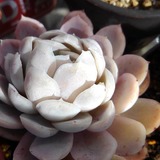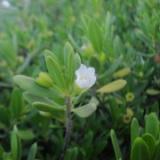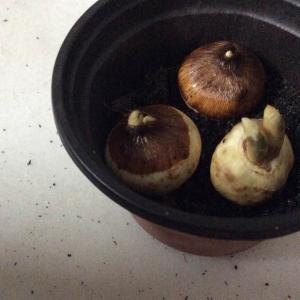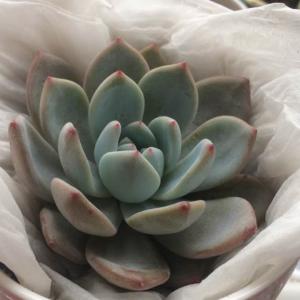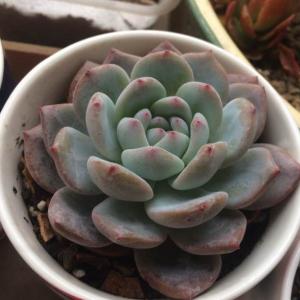文章
Miss Chen
2017年12月23日

Description: This herbaceous perennial plant is 2½–4' tall, branching sparingly. The stout central stem is round and covered with fine hooked hairs. The alternate compound leaves are trifoliate and have petioles about 1–2½" long. The leaflets are up to 3½" long and 1" across. A typical leaflet is lanceolate-oblong or lanceolate-ovate, with smooth margins, and a leathery texture. The base of a leaflet is rounded, while the tip is usually blunt. The lower surface is light or whitish green and has prominent veins; there are hooked hairs along the major veins. The central stem terminates in an elongated raceme of flowers about ½–1½' long. Usually, only a few flowers are in bloom at the same time.

Each flower is about 1/3" (8 mm.) in length (up and down), and either pale purple or white. The two upper petals are larger than the others and well-rounded; when these petals are pale purple, there is a small patch of white near the throat of the flower, which is surrounded by a narrow border of burgundy. There are also two side petals that enclose a lower petal, which project outward. Together, they form a typical pea-shaped flower. The hairy green calyx is divided into 5 lobes of unequal length, while the pedicels of the flowers are slender and hairy. The blooming period usually occurs during mid-summer and lasts about 3 weeks. There is no noticeable floral scent. The flowers are replaced by flat seedpods about 1-3" long that are called 'loments.' These loments have 3-9 segments that are well-rounded on both the upper and lower sides. The surface of these loments are covered with hooked hairs that can cling to clothing or fur. Individual segments of the loments can break off and cling to more than one passing carrier. The root system consists of a stout taproot. Vegetative colonies are not formed.
Cultivation: The preference is full or partial sun, mesic conditions, and a fertile loam or clay loam soil. This plant has good drought tolerance, and it appears to have fewer problems with powdery mildew than some other Desmodium spp., such as Desmodium canadense (Showy Tick Trefoil). If it is grown in full sun, Illinois Tick Trefoil remains quite erect because of its stout central stem. Its root system adds nitrogen to the soil.

Range & Habitat: The native Illinois Tick Trefoil occurs occasionally in most counties of central and northern Illinois, but it is uncommon or absent in many areas of southern Illinois (see Distribution Map). Habitats include mesic to slightly dry black soil prairies, sand prairies (less typical), oak savannas, scrubby barrens, and areas along railroads and roadsides, especially where prairie remnants occur. Usually, this species occurs as scattered plants, and doesn't form the dense colonies of some Desmodium spp., such as Showy Tick Trefoil.
Faunal Associations: The flowers attract long-tongued bees primarily, including bumblebees and leaf-cutting bees (Megachile spp.); only pollen is available as a floral reward. Other insect feed on the leaves, seeds, and other parts of Illinois Tick Trefoil and other tick trefoils (Desmodium spp.). These insects include the seed-eating larvae of Apion reconditum andTrifoliate Leaves other straight-snouted weevils; leaf-mining larvae of Pachyschelus laevigatus (a metallic wood-boring beetle); Colaspis brunnea (Grape Colaspis), Odontota horni (Soybean Leafminer), and other leaf beetles; larvae of Clinodiplosis meibomiifoliae and other gall flies; Aphis glycines (Soybean Aphid) and other aphids; the seed-eating Megalotomus quinquespinosus (Lupine Bug); leaf-eating larvae of Atomacera debilis (an Argid sawfly); flower- and bud-eating larvae of Grapholita fana (Chesire Cat Moth) and larvae of other moths; larvae of Thorybes bathyllus (Southern Cloudywing), Thorybes pylades (Northern Cloudywing), and other skippers; larvae of two butterflies, Everes comyntas (Eastern Tailed Blue) and Strymon melinus (Gray Hairstreak); and Neohydatothrips desmodianus (Tick Trefoil Thrips). The Insect Table provides a more complete list of these insects. Among vertebrate animals, the seeds of tick trefoils are eaten by the Bobwhite Quail, Wild Turkey, and White-footed Mouse (Martin et al., 1951/1961). The foliage is palatable to mammalian herbivores, including deer, rabbits, groundhogs, and livestock. These same animals help to distribute the seedpods, which cling to fur, spreading Illinois Tick Trefoil and other tick trefoils to new areas. People also help to distribute the seedpods because they readily cling to clothing.
Photographic Location: The photographs were taken at the Shortline Railroad Prairie in Champaign County, Illinois. The plants were growing in a mesic black soil prairie not far from a corn field.
Comments: Illinois Tick Trefoil is not very showy because only a few flowers are in bloom at the same time. Unlike other Desmodium spp. (Tick Trefoils), it has high fidelity to prairies, and is less often observed around woodlands. Illinois Tick Trefoil can be readily distinguished from Desmodium canadense (Showy Tick Trefoil), another species that often occurs in prairies, by considering the following features: 1) the former species usually has fewer flowers in bloom at the same time as the latter, 2) the compound leaves of the former have much longer petioles (over 1" long) than the latter, 3) the stipules at the base of the petioles of the former are larger, broader, and more persistant than the stipules of the latter, and 4) the undersides of the leaflets of the former have more prominent veins than the leaflets of the latter. In general, the form and number of segments in the loments are important in distinguishing the different species of Tick Trefoil, while their flowers are very similar in appearance. The loments of other Tick Trefoils usually have fewer segments than Illinois Tick Trefoil, and often the upper sides of their loments are more flat.

Each flower is about 1/3" (8 mm.) in length (up and down), and either pale purple or white. The two upper petals are larger than the others and well-rounded; when these petals are pale purple, there is a small patch of white near the throat of the flower, which is surrounded by a narrow border of burgundy. There are also two side petals that enclose a lower petal, which project outward. Together, they form a typical pea-shaped flower. The hairy green calyx is divided into 5 lobes of unequal length, while the pedicels of the flowers are slender and hairy. The blooming period usually occurs during mid-summer and lasts about 3 weeks. There is no noticeable floral scent. The flowers are replaced by flat seedpods about 1-3" long that are called 'loments.' These loments have 3-9 segments that are well-rounded on both the upper and lower sides. The surface of these loments are covered with hooked hairs that can cling to clothing or fur. Individual segments of the loments can break off and cling to more than one passing carrier. The root system consists of a stout taproot. Vegetative colonies are not formed.
Cultivation: The preference is full or partial sun, mesic conditions, and a fertile loam or clay loam soil. This plant has good drought tolerance, and it appears to have fewer problems with powdery mildew than some other Desmodium spp., such as Desmodium canadense (Showy Tick Trefoil). If it is grown in full sun, Illinois Tick Trefoil remains quite erect because of its stout central stem. Its root system adds nitrogen to the soil.

Range & Habitat: The native Illinois Tick Trefoil occurs occasionally in most counties of central and northern Illinois, but it is uncommon or absent in many areas of southern Illinois (see Distribution Map). Habitats include mesic to slightly dry black soil prairies, sand prairies (less typical), oak savannas, scrubby barrens, and areas along railroads and roadsides, especially where prairie remnants occur. Usually, this species occurs as scattered plants, and doesn't form the dense colonies of some Desmodium spp., such as Showy Tick Trefoil.
Faunal Associations: The flowers attract long-tongued bees primarily, including bumblebees and leaf-cutting bees (Megachile spp.); only pollen is available as a floral reward. Other insect feed on the leaves, seeds, and other parts of Illinois Tick Trefoil and other tick trefoils (Desmodium spp.). These insects include the seed-eating larvae of Apion reconditum andTrifoliate Leaves other straight-snouted weevils; leaf-mining larvae of Pachyschelus laevigatus (a metallic wood-boring beetle); Colaspis brunnea (Grape Colaspis), Odontota horni (Soybean Leafminer), and other leaf beetles; larvae of Clinodiplosis meibomiifoliae and other gall flies; Aphis glycines (Soybean Aphid) and other aphids; the seed-eating Megalotomus quinquespinosus (Lupine Bug); leaf-eating larvae of Atomacera debilis (an Argid sawfly); flower- and bud-eating larvae of Grapholita fana (Chesire Cat Moth) and larvae of other moths; larvae of Thorybes bathyllus (Southern Cloudywing), Thorybes pylades (Northern Cloudywing), and other skippers; larvae of two butterflies, Everes comyntas (Eastern Tailed Blue) and Strymon melinus (Gray Hairstreak); and Neohydatothrips desmodianus (Tick Trefoil Thrips). The Insect Table provides a more complete list of these insects. Among vertebrate animals, the seeds of tick trefoils are eaten by the Bobwhite Quail, Wild Turkey, and White-footed Mouse (Martin et al., 1951/1961). The foliage is palatable to mammalian herbivores, including deer, rabbits, groundhogs, and livestock. These same animals help to distribute the seedpods, which cling to fur, spreading Illinois Tick Trefoil and other tick trefoils to new areas. People also help to distribute the seedpods because they readily cling to clothing.
Photographic Location: The photographs were taken at the Shortline Railroad Prairie in Champaign County, Illinois. The plants were growing in a mesic black soil prairie not far from a corn field.
Comments: Illinois Tick Trefoil is not very showy because only a few flowers are in bloom at the same time. Unlike other Desmodium spp. (Tick Trefoils), it has high fidelity to prairies, and is less often observed around woodlands. Illinois Tick Trefoil can be readily distinguished from Desmodium canadense (Showy Tick Trefoil), another species that often occurs in prairies, by considering the following features: 1) the former species usually has fewer flowers in bloom at the same time as the latter, 2) the compound leaves of the former have much longer petioles (over 1" long) than the latter, 3) the stipules at the base of the petioles of the former are larger, broader, and more persistant than the stipules of the latter, and 4) the undersides of the leaflets of the former have more prominent veins than the leaflets of the latter. In general, the form and number of segments in the loments are important in distinguishing the different species of Tick Trefoil, while their flowers are very similar in appearance. The loments of other Tick Trefoils usually have fewer segments than Illinois Tick Trefoil, and often the upper sides of their loments are more flat.
0
0
文章
Miss Chen
2017年12月23日

Description: This is a herbaceous perennial plant about 2-4' tall that is either unbranched or sparingly so. The central stem is light green, grooved, and either glabrous or sparsely pubescent. The alternate compound leaves are bipinnate and up to 8" long; they have a ferny appearance. Each compound leaf has 8-12 pairs of even-pinnate leaflets; each even-pinnate leaflet consists of 20-40 pairs of closely spaced subleaflets. Individual subleaflets are about 1/8" (3 mm.) long and about one-third as much across; they are light to medium green, lanceolate-oblong in shape, ciliate along their margins, and sessile (or nearly so). The rachises (central stalks) of the compound leaves are whitish green from fine hairs and they are grooved along their upper sides.
Small white flowerheads occur individually from the axils of the upper leaves on slender peduncles up to 3" long. The peduncles are glabrous to sparsely hairy. Each flowerhead is up to ½" across and ovoid-globoid in shape; it consists of a dense head of 25-50 florets that are oriented in nearly all directions. Each floret consists of a short-campanulate calyx with 5 teeth (less than 1 mm. in length), 5 white petals (about 1 mm. in length), an ovary with a single style, and 5 strongly exerted stamens. The stamens have white filaments and pale yellow anthers. When they are fully developed, these flowerheads have a starburst appearance that is typical of compound flowers in the Mimosa family, but they appear more lumpy than spherical because the florets bloom from the bottom to the top gradually, rather than all at once. The blooming period lasts 1-2 months during the summer. There is no noticeable floral scent. Afterwards, the flowerheads are replaced by clusters of 5-15 seedpods that become dark brown at maturity. Individual seedpods are about ½" in length and two-valved; they are curved and flattened. Each seedpod splits open along its valves, releasing 2-5 seeds. The seeds are reddish brown, ovoid-reniform in shape, somewhat flattened, and shiny. This plant spreads by reseeding itself.

Cultivation: The preference is full to partial sun and moist to mesic conditions. Some drought is tolerated, but the leaflets on the lower stems of the plant may fall off, and the buds of compound flowers may abort and turn brown. Growth is best in fertile loam, but other kinds of soil are readily tolerated. This plant fixes nitrogen in the soil. Foliar disease is rarely a problem.
Range & Habitat: The native Illinois Bundleflower occurs primarily in NE Illinois, along the Illinois River valley in central Illinois, and along the Mississippi River valley in SW Illinois, favoring loamy or sandy alluvial soils. This plant is occasional in these areas, while in other areas of the state it is uncommon or absent (see Distribution Map). Habitats include black soil prairies, moist meadows near rivers, openings in woodlands, limestone glades, areas along railroads, and areas along levees. Because of the relatively high protein content of its foliage, Illinois Bundleflower has been planted in pastures to feed cattle, and it can be used in prairie restorations to improve worn-out soil. However, it recovers poorly from wildfires. Relatively open areas with a history of disturbance are preferred.

Faunal Associations: The flowerheads are occasionally visited by small bees and flies that seek nectar and pollen. The medium-sized seeds are consumed by various upland gamebirds, including the Ring-Necked Pheasant, Bobwhite Quail, and Greater Prairie Chicken. The foliage of this plant is highly palatable to mammalian herbivores because of its high protein content. It may have trouble surviving in areas where there is a surplus population of these animals and a shortage of predators.
Photographic Location: Photographs were taken at the webmaster's wildflower garden in Urbana, Illinois.

Comments: The primary attraction of Illinois Bundleflower is the refined appearance of its fern-like foliage. The subleaflets of the compound leaves fold together at night, and they close partially during hot sunny days in order to reduce moisture loss. During the morning and evening, when sunlight is less intense, the compound leaves orient themselves in the direction of the sun in order to maximize the reception of its light. The small white flowerheads are short-lived and not particularly showy. Illinois Bundleflower is one of two members of the Mimosa family that occur in prairies in Illinois. The other plant, Schrankia uncinata (Sensitive Brier), is a sprawling vine that has pink starburst flowerheads and prickles along its stems and compound leaves.
Small white flowerheads occur individually from the axils of the upper leaves on slender peduncles up to 3" long. The peduncles are glabrous to sparsely hairy. Each flowerhead is up to ½" across and ovoid-globoid in shape; it consists of a dense head of 25-50 florets that are oriented in nearly all directions. Each floret consists of a short-campanulate calyx with 5 teeth (less than 1 mm. in length), 5 white petals (about 1 mm. in length), an ovary with a single style, and 5 strongly exerted stamens. The stamens have white filaments and pale yellow anthers. When they are fully developed, these flowerheads have a starburst appearance that is typical of compound flowers in the Mimosa family, but they appear more lumpy than spherical because the florets bloom from the bottom to the top gradually, rather than all at once. The blooming period lasts 1-2 months during the summer. There is no noticeable floral scent. Afterwards, the flowerheads are replaced by clusters of 5-15 seedpods that become dark brown at maturity. Individual seedpods are about ½" in length and two-valved; they are curved and flattened. Each seedpod splits open along its valves, releasing 2-5 seeds. The seeds are reddish brown, ovoid-reniform in shape, somewhat flattened, and shiny. This plant spreads by reseeding itself.

Cultivation: The preference is full to partial sun and moist to mesic conditions. Some drought is tolerated, but the leaflets on the lower stems of the plant may fall off, and the buds of compound flowers may abort and turn brown. Growth is best in fertile loam, but other kinds of soil are readily tolerated. This plant fixes nitrogen in the soil. Foliar disease is rarely a problem.
Range & Habitat: The native Illinois Bundleflower occurs primarily in NE Illinois, along the Illinois River valley in central Illinois, and along the Mississippi River valley in SW Illinois, favoring loamy or sandy alluvial soils. This plant is occasional in these areas, while in other areas of the state it is uncommon or absent (see Distribution Map). Habitats include black soil prairies, moist meadows near rivers, openings in woodlands, limestone glades, areas along railroads, and areas along levees. Because of the relatively high protein content of its foliage, Illinois Bundleflower has been planted in pastures to feed cattle, and it can be used in prairie restorations to improve worn-out soil. However, it recovers poorly from wildfires. Relatively open areas with a history of disturbance are preferred.

Faunal Associations: The flowerheads are occasionally visited by small bees and flies that seek nectar and pollen. The medium-sized seeds are consumed by various upland gamebirds, including the Ring-Necked Pheasant, Bobwhite Quail, and Greater Prairie Chicken. The foliage of this plant is highly palatable to mammalian herbivores because of its high protein content. It may have trouble surviving in areas where there is a surplus population of these animals and a shortage of predators.
Photographic Location: Photographs were taken at the webmaster's wildflower garden in Urbana, Illinois.

Comments: The primary attraction of Illinois Bundleflower is the refined appearance of its fern-like foliage. The subleaflets of the compound leaves fold together at night, and they close partially during hot sunny days in order to reduce moisture loss. During the morning and evening, when sunlight is less intense, the compound leaves orient themselves in the direction of the sun in order to maximize the reception of its light. The small white flowerheads are short-lived and not particularly showy. Illinois Bundleflower is one of two members of the Mimosa family that occur in prairies in Illinois. The other plant, Schrankia uncinata (Sensitive Brier), is a sprawling vine that has pink starburst flowerheads and prickles along its stems and compound leaves.
0
0
文章
Miss Chen
2017年12月22日

Description: This perennial wildflower is about 1-2' tall, branching occasionally to frequently. It is ascending to erect, although some of the side branches may sprawl across the ground in open areas. The central stem and side branches are light green, hairless, and terete or angular in cross-section. The alternate compound leaves are odd-pinnate with 5-15 pairs of leaflets and a terminal leaflet; the compound leaves are up to 3" long and they have short petioles. Individual leaflets are 3/8" long and 1/8" across; they are medium green, oblong, hairless, and smooth along their margins. Each leaflet has a very shortFloral Spike petiole and a tiny pointed tip. Upper stems terminate in individual spikes of flowers that are short and cylindrical in shape; individual flowers and their bracts are densely crowded together along the length of each spike in all directions. The petals of these flowers are medium purple or rose-pink (rarely white), while their sepals and bracts are green-white. Each flower has 5 petals, 5 sepals, 5 stamens, and a pistil with a single style. The petals are oblanceolate or obovate and longer than the sepals. The short sepals are lanceolate with green tips and white bases. Underneath each flower, there is a lanceolate bract with an elongated tip that is awn-like. The exerted stamens have white or pale purple filaments and orange to brown stamens. The blooming period occurs from mid- to late summer and lasts about 1-2 months. There is no noticeable floral scent. Each flower is replaced by a short seedpod with a slender beak that is largely enclosed by the persistent sepals; each seedpod contains 1-2 smooth seeds. As the seeds mature, the floral spikes become dark brown. The root system consists of a short stout taproot with fibrous rootlets. This wildflower reproduces by reseeding itself. Individual plants typically live less than 8 years.
Cultivation: The preference is full or partial sunlight (at least one-half day of sunlight), moist to slightly dry conditions, and a thin rocky soil. The pH of the soil should lie within the range 6.0–8.0; strongly acidic soil should be avoided. This wildflower will adapt to ordinary clay-loam garden soil if its location is sunny and well-drained; however, it is intolerant of competition from taller and more aggressive plants.
Range & Habitat: Leafy Prairie Clover has been observed in only a few counties in northern Illinois (see Distribution Map). Today, it is restricted to 2-3 small colonies in Will County; the populations of the remaining colonies have been extirpated by development or over-collection. Leafy Prairie Clover also occurs in Tennessee and Alabama. Populations have declined in all three states. This native plant is quite rare and it is listed as 'endangered' by both the state of Illinois and the Federal government. In Illinois, habitats are restricted to mesic dolomite prairies and rocky riverbanks. In Tennessee and Alabama, habitats are restricted to cedar glades and meadows along the edges of cedar glades.
Faunal Associations: Floral visitors of Leafy Prairie Clover are probably similar to the floral visitors of Dalea purpurea (Purple Prairie Clover); the insect visitors of the latter include many kinds of bees (short-tongued & long-tongued), butterflies, flies, and occasional wasps. These insects are attracted to the nectar and/or pollen of the flowers. The caterpillars of the butterfly Colias cesonia (Dogface Sulfur) feeds on the foliage of Dalea spp. (Prairie Clovers) and other species in the Bean family. Other insects that feed on Prairie Clovers include Apion amaurum (Weevil sp.), Apion capitone (Weevil sp.), and Pachybrachis othonus (Cylindrical Leaf Beetle sp.); none of these records are specific to Leafy Prairie Clover, however. The foliage of Leafy Prairie Clover is highly palatable to mammalian herbivores, including deer, rabbits, groundhogs, cattle, horses, and others. In Illinois, rabbits have been a major cause of plant mortality for this species. This rare wildflower should be protected from such animals where their populations are excessive.

Photographic Location: The wildflower garden of the webmaster in Urbana, Illinois; the photographed plant was obtained from a specialist nursery using horticultural sources, rather than wild-collected material.
Comments: Unfortunately, this attractive wildflower is approaching extinction in natural areas. Compared to other Dalea spp. (Prairie Clovers), it has a more leafy appearance. Leafy Prairie Clover can be distinguished from other Prairie Clovers in Illinois by the number of leaflets per compound leaf (typically 21-25, although there can be fewer or more leaflets than this). Both Dalea purpurea (Purple Prairie Clover) and Dalea candida (White Prairie Clover) have fewer leaflets per compound leaf (less than 10). As it common name suggests, White Prairie Clover has flowers with white petals. The floral bracts of Purple Prairie Clover are shorter than those of Leafy Prairie as they lack the awn-like tips of the latter. A species that is found in neighboring states (although not Illinois), Dalea villosa (Silky Prairie Clover) has abundant leaflets, but its foliage is covered with abundant silky hairs. In contrast, Leafy Prairie Clover has hairless foliage.
Cultivation: The preference is full or partial sunlight (at least one-half day of sunlight), moist to slightly dry conditions, and a thin rocky soil. The pH of the soil should lie within the range 6.0–8.0; strongly acidic soil should be avoided. This wildflower will adapt to ordinary clay-loam garden soil if its location is sunny and well-drained; however, it is intolerant of competition from taller and more aggressive plants.
Range & Habitat: Leafy Prairie Clover has been observed in only a few counties in northern Illinois (see Distribution Map). Today, it is restricted to 2-3 small colonies in Will County; the populations of the remaining colonies have been extirpated by development or over-collection. Leafy Prairie Clover also occurs in Tennessee and Alabama. Populations have declined in all three states. This native plant is quite rare and it is listed as 'endangered' by both the state of Illinois and the Federal government. In Illinois, habitats are restricted to mesic dolomite prairies and rocky riverbanks. In Tennessee and Alabama, habitats are restricted to cedar glades and meadows along the edges of cedar glades.
Faunal Associations: Floral visitors of Leafy Prairie Clover are probably similar to the floral visitors of Dalea purpurea (Purple Prairie Clover); the insect visitors of the latter include many kinds of bees (short-tongued & long-tongued), butterflies, flies, and occasional wasps. These insects are attracted to the nectar and/or pollen of the flowers. The caterpillars of the butterfly Colias cesonia (Dogface Sulfur) feeds on the foliage of Dalea spp. (Prairie Clovers) and other species in the Bean family. Other insects that feed on Prairie Clovers include Apion amaurum (Weevil sp.), Apion capitone (Weevil sp.), and Pachybrachis othonus (Cylindrical Leaf Beetle sp.); none of these records are specific to Leafy Prairie Clover, however. The foliage of Leafy Prairie Clover is highly palatable to mammalian herbivores, including deer, rabbits, groundhogs, cattle, horses, and others. In Illinois, rabbits have been a major cause of plant mortality for this species. This rare wildflower should be protected from such animals where their populations are excessive.

Photographic Location: The wildflower garden of the webmaster in Urbana, Illinois; the photographed plant was obtained from a specialist nursery using horticultural sources, rather than wild-collected material.
Comments: Unfortunately, this attractive wildflower is approaching extinction in natural areas. Compared to other Dalea spp. (Prairie Clovers), it has a more leafy appearance. Leafy Prairie Clover can be distinguished from other Prairie Clovers in Illinois by the number of leaflets per compound leaf (typically 21-25, although there can be fewer or more leaflets than this). Both Dalea purpurea (Purple Prairie Clover) and Dalea candida (White Prairie Clover) have fewer leaflets per compound leaf (less than 10). As it common name suggests, White Prairie Clover has flowers with white petals. The floral bracts of Purple Prairie Clover are shorter than those of Leafy Prairie as they lack the awn-like tips of the latter. A species that is found in neighboring states (although not Illinois), Dalea villosa (Silky Prairie Clover) has abundant leaflets, but its foliage is covered with abundant silky hairs. In contrast, Leafy Prairie Clover has hairless foliage.
1
0
文章
Miss Chen
2017年12月22日

Description: This perennial plant is unbranched or sparsely branched in the upper half, and 1-2½' tall. The pale green central stem has light longitudinal lines. The alternate compound leaves are oddly pinnate and about 2-7" long, consisting of 3-9 pale green leaflets. Each leaflet is linear or narrowly oblanceolate, about 1" long and less than ¼" across. The margins are smooth, and the underside of each leaflet has numerous translucent dots. Both the stems and leaves are hairless. There is a short cylindrical spike of white flowers at the terminus of the central stem and each of the major side stems. This spike is about 1-3" tall and ¾" across. The small flowers form a wreath around the bottom of the spike, which moves upward as the season progresses. Each flower is about ¼" across, with 5 petals and 5 white stamens. The flowers often have a pleasant fragrance. The blooming occurs during early to mid-summer and lasts about a month. The seeds fall a short distance from the mother plant when the wind shakes the cylindrical spikes. The root system consists of a central taproot that can extend 5' into the ground.
Cultivation: The preference is full sun and mesic to dry conditions. The soil can contain significant amounts of loam, clay, sand, or gravel. This plant is slow to develop, but otherwise easy. Foliar disease isn't troublesome. Drought resistance is very good.
Range & Habitat: The native White Prairie Clover occurs occasionally in scattered counties of Illinois, but it is rare or absent in the SE section of the state (see Distribution Map). Habitats include mesic to dry black soil prairies, sand prairies, savannas, openings in upland forests, and limestone glades. It is rarely observed in highly disturbed areas. Recovery from occasional wildfires is good.
Faunal Associations: The nectar and pollen of the flowers attract bumblebees, Halictid bees (including green metallic bees), plasterer bees (Colletes spp.), Sphecid wasps, Tiphiid wasps, Syrphid flies, thick-headed flies (Conopidae), and small butterflies. Two oligolectic plasterer bees, Colletes robertsonii and Colletes wilmattae, visit the flowers of White Prairie Clover (Robertson, 1929; Krombein et al., 1979). Other insects feed on the seeds, foliage, and other parts of this plant. They include such species as the larvae of two butterflies, Colias cesonia (Dogface Sulphur) and Hemiargus isola (Reakirt's Blue), the seed-eating larvae of two weevils, Apion amaurum and Apion capitone, and Melanoplus keeleri luridus (Keeler's Grasshopper); see Opler & Krizek (1984), Sauer (2005), and Campbell et al. (1974). This plant is palatable and high in protein, therefore it is readily consumed by mammalian herbivores of all kinds, including rabbits, groundhogs, deer, and livestock. This can cause difficulties in establishing this plant in some areas. It is possible that small rodents may carry the seeds to their dens. Because of their high mortality rate, some of the seeds will remain uneaten, and thus are dispersed by these rodents.

Photographic Location: Photographs were taken at the Lincoln Book Bindery in Urbana, Illinois.
Comments: White Prairie Clover often occurs in the same habitats as Dalea purpurea (Purple Prairie Clover) – the two are often seen together, although the former begins blooming about 2 weeks earlier than the latter. However, White Prairie Clover is the less common of the two plants. The most obvious difference between them is the coloration of their flowers. In addition, White Prairie Clover tends to have more elongated flowering spikes with hair-like bracts, and its foliage is longer, sparser, with a lighter shade of green. Prior to blooming, it blends into the background of grasses and other forbs rather well, and is easy to overlook.
Cultivation: The preference is full sun and mesic to dry conditions. The soil can contain significant amounts of loam, clay, sand, or gravel. This plant is slow to develop, but otherwise easy. Foliar disease isn't troublesome. Drought resistance is very good.
Range & Habitat: The native White Prairie Clover occurs occasionally in scattered counties of Illinois, but it is rare or absent in the SE section of the state (see Distribution Map). Habitats include mesic to dry black soil prairies, sand prairies, savannas, openings in upland forests, and limestone glades. It is rarely observed in highly disturbed areas. Recovery from occasional wildfires is good.
Faunal Associations: The nectar and pollen of the flowers attract bumblebees, Halictid bees (including green metallic bees), plasterer bees (Colletes spp.), Sphecid wasps, Tiphiid wasps, Syrphid flies, thick-headed flies (Conopidae), and small butterflies. Two oligolectic plasterer bees, Colletes robertsonii and Colletes wilmattae, visit the flowers of White Prairie Clover (Robertson, 1929; Krombein et al., 1979). Other insects feed on the seeds, foliage, and other parts of this plant. They include such species as the larvae of two butterflies, Colias cesonia (Dogface Sulphur) and Hemiargus isola (Reakirt's Blue), the seed-eating larvae of two weevils, Apion amaurum and Apion capitone, and Melanoplus keeleri luridus (Keeler's Grasshopper); see Opler & Krizek (1984), Sauer (2005), and Campbell et al. (1974). This plant is palatable and high in protein, therefore it is readily consumed by mammalian herbivores of all kinds, including rabbits, groundhogs, deer, and livestock. This can cause difficulties in establishing this plant in some areas. It is possible that small rodents may carry the seeds to their dens. Because of their high mortality rate, some of the seeds will remain uneaten, and thus are dispersed by these rodents.

Photographic Location: Photographs were taken at the Lincoln Book Bindery in Urbana, Illinois.
Comments: White Prairie Clover often occurs in the same habitats as Dalea purpurea (Purple Prairie Clover) – the two are often seen together, although the former begins blooming about 2 weeks earlier than the latter. However, White Prairie Clover is the less common of the two plants. The most obvious difference between them is the coloration of their flowers. In addition, White Prairie Clover tends to have more elongated flowering spikes with hair-like bracts, and its foliage is longer, sparser, with a lighter shade of green. Prior to blooming, it blends into the background of grasses and other forbs rather well, and is easy to overlook.
0
0


